
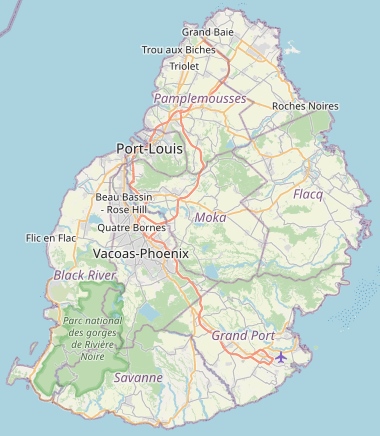
Map © OpenStreetMap contributors (info) | |
|
Mauritius Capital Area Population Languages Currency |
Port Louis 2 040 km2 1 261 000 English, French, Creole Mauritian Rupee (MUR) |
The Republic of Mauritius comprises two main islands and several smaller ones in the Indian Ocean, about 850 kilometres east of Madagascar. None of the islands were inhabited until Dutch explorers landed in 1598 and established a settlement; it was during this period of Dutch rule that the ebony forests were decimated and the dodo was hunted to extinction. The Dutch abandoned the place in 1710 and a few years later French settlers arrived. The ongoing war with Great Britain resulted in Mauritius being ceded to the British in 1810, although the French way of life that had been established continued virtually unchanged. Independence from colonial rule was finally achieved in 1968 and in 1992 Mauritius became a republic. | |
If you enjoyed reading this, please send me an email. All correspondence is appreciated!
[Monday 14 September 2015 : Cape Town, South Africa] A long, hard day of travelling began with a 3 AM wake-up, followed by a trip to the airport at 4 AM, check-in for our flights to Johannesburg and Mauritius at 5 AM and eventual departure at 6 AM. The early morning "red eye" flight to Johannesburg was filled to the brim with self-important business commuters, brandishing briefcases, suits and grim expressions, amongst whom we stood out like hippies at a bean counters' convention. But we had a tail wind so we arrived in Johannesburg twenty minutes early, which gave us more than enough time to savour some excellent coffee at a place called Jackson's in the airport.
The South African Airways international flight to Mauritius was only four hours long, but it seemed longer because the aircraft was only fitted out with the basics - no private seat-back TV screens, no in-flight movies, nothing but SAA's Sawubona magazine. But the food was good and I solved several Sudoku puzzles to while away the time.
There is a two hour time difference between South Africa and Mauritius, so even though we left Johannesburg quite early we landed at 3:30 in the afternoon. The airport in Mauritius appears to be brand new and was a pleasure, with gleaming floors and wide open, airy spaces. You can even see the sea from inside the terminal buildings! Before we knew it we were through Immigration, Customs and a mandatory health check, running the gauntlet of a posse of taxi and hotel operators (none of whom were very hard-sell, it must be said). We escaped with our wallets intact and easily found the bus stop up a ramp in the public car park. Unfortunately several buses went past that were going in the wrong direction, and just when we were thinking about getting a taxi a Mahebourg bus pulled up.
Fifteen minutes later we got off at Mahebourg bus station and walked 200 metres up the road to the guest house we'd booked into that night - a place called Le Bamboo, a name that implies an air of tropical romanticism but which was shown on closer inspection to be entirely misleading. Decrepitude aside, our room was clean, the shower was excellent and we had great views down the river from the balcony outside. Supper was Chinese food - despite centuries of French and British rule, the number of Chinese restaurants here seems to outnumber all others; come to think of it, isn't that how it is all over the world?
[Tuesday 15 September : Mahebourg, Mauritius] We spent the day finding our feet and getting acclimatised to the heat and humidity of this tropical country. Getting a Mauritian SIM card for Karen's cell phone proved simple at first, but it became a protracted source of frustration because Orange's system (Orange seems to be the main, perhaps only, mobile operator here) stubbornly refused to register her number on the network. When we went back to the store to try to get it fixed, they merely came up with the standard excuse used the world over : "It's a technical problem. Try again tomorrow". Why does nothing like this ever work first time?
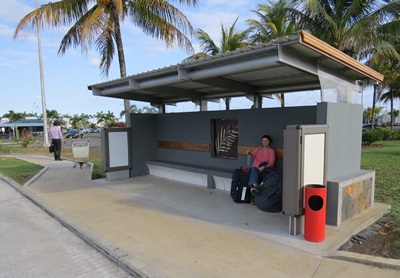
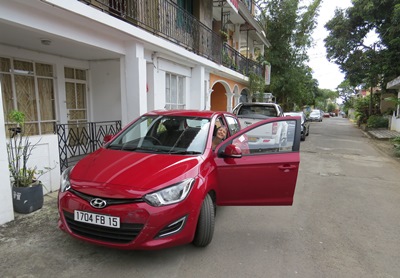
[Wednesday 16 September : La Gaulette, Mauritius] The rental car we'd ordered from a place called Ebrahim Tours (they were strongly recommended on both TripAdvisor and Lonely Planet) arrived promptly outside our guest house door at 9:30 AM. The young guy who drove the car to Mahebourg from their office in Grand Baie on the north coast explained everything in halting English then strolled off down the road to the bus station, whistling happily. Not a bad job, I guess - deliver cars all over the island then take a bus back to the office.
We checked out of the guest house, loaded our gear into the car then headed off into the Mauritian traffic. The car was a red Hyundai i10, 5-speed manual hatchback and it handled very easily. Driving was a snap, particularly in light of the fact that traffic in Mauritius is on the LEFT, not the right - one of the legacies of British rule. First stop was the telecom office, where Karen finally sorted out her cell phone connectivity, then we headed out of Mahebourg on the coast road towards Blue Bay. Our intention was to go round the island in a clockwise direction, and because we weren't sure how far we'd get each day we hadn't booked any accommodation apart from the first two nights; we would just have to "wing it".
Blue Bay is a large inlet on the south-east coast, famed for the bright blue colour of its water, and I can confirm that it is indeed as blue as the tourist brochures promise. Unfortunately we were set upon by touts intent on selling shell necklaces, boat rides and trinkets ... one of the hazards of public beaches in Mauritius (as opposed to the private beaches owned by big luxury resorts). But I enjoyed a long swim in the lukewarm water before we continued on our clockwise route round the island. We passed through the towns of Pleine Magnien, L'Escalier, Riviere des Anguilles and Souillac (including a lunch stop at the famous Gris Gris beach) before rejoining the scenic south coast road. We were often only metres from the sea, and on a few occasions waves actually burst over the road in front of our car - that road must surely get flooded quite often at spring tide, or during major storms.
According to our map, near Baie du Cap the road veers inland a long way to skirt a bay of the same name, but when we arrived there we discovered a new bridge over the lagoon. The long detour into the forest appeared no longer to be in use, but Karen was undeterred and turned down the old road anyway. "Looks like fun" she said. "Let's go that way". We quickly discovered what happens to abandoned roads on tropical islands - they become overgrown and impassable very rapidly indeed, but we persevered through increasingly thick vegetation until even Michelle Schumacher (our driver, aka Karen) finally had to admit defeat. The road simply ended at the water's edge, with about 50 metres of open water between us and the continuation of the road on the other side. It looked like there had once been a simple bridge or ford which had been washed away. There was no way we could turn around on that overgrown road, so we had to reverse all the way back until we managed to turn in a small clearing.
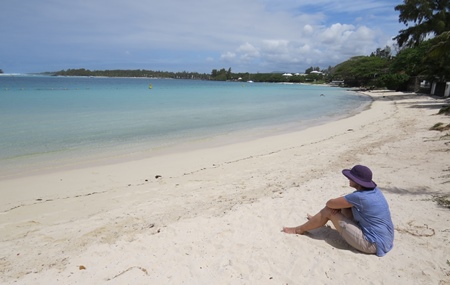
Then we were at the Morne Peninsula, a hammer-shaped wedge of land jutting out of the west coast of Mauritius. By this time of the afternoon we needed somewhere to stay, so we drove down the road into the peninsula and were confronted by walls twenty feet high (yes, 20 feet), huge gates, guards in immaculate uniforms and absolutely no access to the beach for plebs like us. We drove past several luxury resort hotels, none of which you could even get into because they all had massive double gates that were firmly shut. I guess they mostly take package tourists who get bussed in from the airport and who stay inside the resort for the duration of their stay, never venturing out into the "real" Mauritius.
We managed to pull off the road at one narrow section of public beach and phoned a couple of the luxury resorts we'd passed. The receptionist at the first one seemed nonplussed that people would actually phone up and ask for a room for the night and had to transfer me to somebody else in order to answer this very difficult request. She too was taken aback and had to consult various computers and booking systems before returning to the phone and saying that yes, they had a room for the night and it would cost 602 Euros. 602 Euros! That's about 8000 South African Rands! I resisted the impulse to tell her that we didn't want to BUY the room, just sleep in it for a night or two. But I fear my sarcasm would have been wasted so I simply said "Merci madame, au revoir" and ended the call. I suppose "walk in" guests like us are just a nuisance to these all-inclusive luxury resorts so they quote absurd prices to keep them away; they'd rather have package tourists who book months in advance via a travel agent and stay a week at a time.
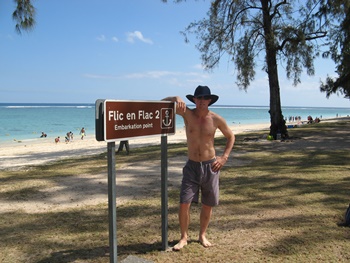
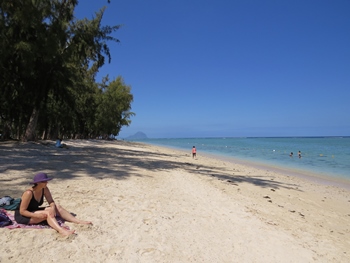
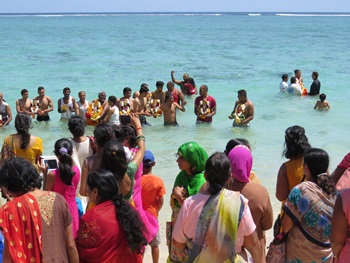
So we turned round, headed back the way we'd come and turned north onto the road up the west coast. Our theory was that we would sooner or later come across a small hotel or guest house ... and so it proved. In the village of La Gaulette we saw a sign for "Happy Days Guest House" and followed it up a steep hill. The owners were just leaving as we arrived, but they showed us around and gave us a fantastic room with a balcony and an uninterrupted view out over the Indian Ocean. And it cost only a fraction of 602 Euros.
[Thursday 17 September : La Gaulette, Mauritius] After an excellent breakfast (including Nespresso coffee) at our guest house, we drove up the coast road to Casa Noyale then turned inland to the Black River Gorges national park. This is a mountainous, thickly-forested area in the south-west of Mauritius, cut through by two rivers - the grand and petit Black Rivers. We wanted to spend the morning walking one of the trails in the park, but we found that the visitor centre had been vandalised a few days before and was closed, so we could not get one of the detailed maps they are reported to have. We tried to follow the signs for a route to a viewpoint and a waterfall, but despite a couple of hours of clambering and boulder hopping we found neither and eventually gave up. The forest is beautiful, but strangely lacking in both diversity and large, old trees - most of the trees seemed to be saplings. How could that be? In an indigenous rain forest you find a profusion of trees of all types, sizes and ages, growing haphazardly and at random. It looked like some natural catastrophe had destroyed 95% of the trees at a certain point (perhaps ten years ago), and most of what we saw had grown since then. It was a minor mystery, but with all the offices at the visitor centre closed there was nobody we could ask.
On the way we back to the main road we stopped at a place called Frenchie's Cafe and had some more excellent coffee. But it was Nespresso again - does nobody in this country have a proper espresso machine? The coffee here is also very expensive, usually between 75 and 100 Rupees (30 to 40 SA Rands).
Then it was on to Chamarel via an incredibly steep and twisting road into the mountains - multiple sharp hairpin bends and even a section that was set up as a permanent one-way (a "stop-go") with a traffic light at each end regulating which direction the traffic could flow. The Chamarel waterfalls were fairly spectacular, but the famous "seven coloured earths" nearby were somewhat of an anti-climax; this is an area of dunes comprising sand of seven distinct colours (red, brown, violet, green, blue, purple and yellow), resulting in an unusual appearance, almost as if the sand had been stained or painted different hues. More interesting was my successful attempt at photo-bombing a group of Chinese tourists ... no harm done though - between them they must have taken several hundred pictures, so one bombed one won't make any difference.
Nearby, some giant tortoises were on display in a shockingly small enclosure. Why couldn't they give the poor creatures a little more space to roam around in? It's amazing - we humans have successfully managed to eradicate all endemic tortoises in Mauritius, so what do we do? Import alien tortoises from Madagascar or the Seychelles and lock them in a tiny enclosure so tourists can gush over them. It's not as if there isn't enough space - the Black River Gorges national park comprises over 60 square kilometres of mountain and forest, so a couple of hectares for these "zoo tortoises" wouldn't go amiss. But then, of course, they wouldn't be instantly and immediately accessible to selfie-clicking (paying) tourists ...
[Friday 18 September : La Gaulette, Mauritius] After a couple of grey days the sky was crisp and clear today, so we headed for Flic en Flac beach up the west coast. This beach is very well known and the location of several luxury resorts such as La Pirogue and Sugar Beach, so we expected the same high walls and ultra security that we'd seen at the Morne Peninsula. But no - Flic en Flac is an actual town, with public roads, shops, restaurants and guest houses, and most of the beach is accessible to the public. The big luxury resorts are at the south end of the road parallel to the beach and are not completely isolated from the real world outside their gates. The beach itself is fantastic; there are large trees that provide lots of shade for people who don't want to be roasted in the sun, acres of free parking and clean, well-maintained toilets.
We parked and walked along the beach, found a shady spot, swam and read our books. Unfortunately the water, while clean and sparkling, wasn't that warm so the swimming was rather brief. Later on we noticed a commotion down the beach and went to have a look; it turns out that today was the last day of the Hindu Ganesha Chaturthi festival, celebrated for ten days in honour of the elephant-headed god Ganesh. The people on the beach were a crowd of Hindus in traditional, brightly-coloured clothes, carrying clay images of Ganesh which were blessed by a swami (a Hindu holy man) and then ceremonially immersed in the sea. There were loads of foreigners on the outskirts of the crowd, watching the ceremony and taking photographs.
We left Flic en Flac in the afternoon and headed south-east via a tortuous inland route to Grand Bassin, high in the mountains in the Black River Gorges national park. Grand Bassin is a crater lake that is sacred to Hindu culture (it is believed to be spiritually connected to the Ganges River in India) and there we found a huge crowd of Hindus chanting and immersing their Ganesh idols in the water. Nearby is a massive statue of the Hindu god Mangal Mahadev (Shiva); across the road an even bigger statue of Durga Maa Bhavani is under construction.
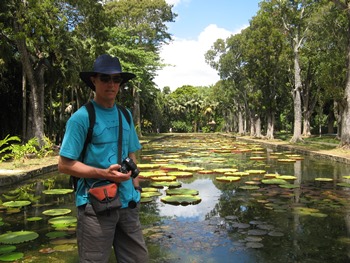
The road back to La Gaulette went via a fenced-in viewpoint high in the mountains that afforded a splendid view of the Black River Gorges. While we were there we succumbed to the wiles of a guy selling sugar cane juice and bought a cup of cane juice each; however, we've both cut down on sugar so much that we found the stuff to be too sickly sweet. But I guess it was an authentic taste of the "real" Mauritius ... By this time it was late afternoon and getting gloomy, but a little further down the road we stopped the car again and forced our weary legs down a precipitous path to another viewpoint. This time the view was of the Alexandra Falls, but they were rather disappointing so we didn't linger but drove back down the twisting mountain road via Chamarel, Casa Noyale and La Gaulette to the Happy Days Guest House, where the swimming pool and a comfy bed soothed our tired bodies.
[Saturday 19 September : Pereybere, Mauritius] We said goodbye to our excellent digs of the last three days and headed north again. We wanted to get onto Mauritius' one and only freeway that connects Mahebourg, Curepipe, Port Louis and Grand Baie BEFORE we reached the snarled traffic of Port Louis but failed dismally; before we knew it we were in the centre of Port Louis and being forced down Government Avenue because we were in a lane that became "right turn only" and I couldn't turn off in time. A few u-turns, some sweaty palms and several anxious moments later we succeeded in getting out of the city and onto the freeway ... except that this freeway has roundabouts (traffic circles) in place of off-ramps, bus stops and cars stopping at random. But it was still faster than the other roads we'd been on so we made good time to the town of Pamplemousses.
Pamplemousses is famous for the botanical gardens nearby - the Sir Seewoosagur Ramgoolam Botanical Garden, named in honour of the man who was prime minister of Mauritius when the country gained independence from Great Britain (and is regarded as the Father of the Nation). It is a calm and restful place, full of indigenous and exotic plants of all kinds, shady paths, ponds and two enclosures containing deer (imported from Java by the original Dutch settlers) and some truly giant tortoises. The gardens are not overwhelmingly big like Kirstenbosch in South Africa, but they are immaculately maintained and very pleasant to wander around.
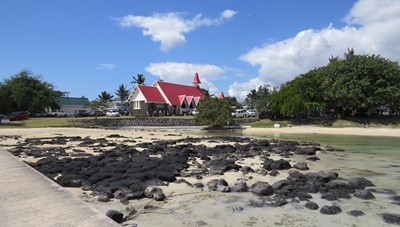
Then it was back into our little red rental bug and onto the freeway north to Grand Baie. Ten minutes later we arrived at the north coast, tourist headquarters and the area known as "party central" in Mauritius. Shops, restaurants, dive centres, hotels and scooter rental places line both sides of the main road that runs east-west next to the sea. We pootled along slowly, absorbing the atmosphere and looking out for somewhere to stay. A little further on from Grand Baie we came to Pereybere, a slightly quieter and less frenetic area, parked at the public beach and walked around. At a dive shop we spoke to a guy who showed us an apartment a block away from the sea; it was very cheap and well kitted-out but it was dim and poky and up a narrow spiral staircase that I suspected would cause one (or both) of us serious injury sooner or later.
We declined the offer of the apartment, went back outside and walked down the lane next to the public beach which leads to Pointe d'Azur. There we found the Ocean Beauty Boutique Hotel, well hidden in clusters of palm trees. It was right on the beach (in fact, the water laps up against the retaining wall in front of the hotel) and looked very nice indeed. Stone pathways between the trees, ponds containing koi fish, a swimming pool with an "horizon overflow" and an extensive breakfast convinced us, so we checked in for the next three nights. Amazingly it was the same place that I'd looked at on Booking.com a few days before, and by dint of a little negotiation we got the room at the same price as that quoted on Booking.com (which is usually less than a hotel's standard "rack rate").
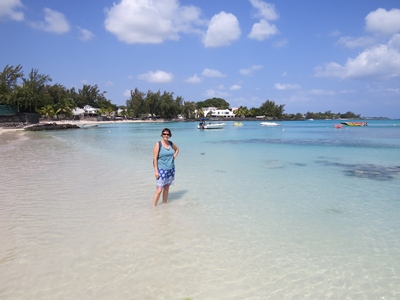
[Sunday 20 September : Pereybere, Mauritius] Having already explored the entire south and west coasts of the island, today we tried to complete the loop by visiting the north and east. Unfortunately the roads are narrow, traffic is slow and there is a lot of congestion in the touristed areas so we didn't quite make it all the way round - we got as far as the town of Trou d'Eau Douce at the southern end of the main beach on the east coast (near the ultra luxury One & Only Le Touessrok hotel) and turned back. So the area between Trou d'Eau Douce and Mahebourg will remain unexplored by us ... on this trip at least. Perhaps another time?
But it was an interesting day, starting from just east of Grand Baie on the northern coastal road. Most of the time the road wound between hotels, villas and private residences behind high walls, with occasional glimpses of the sea and a few scattered public beaches. The church of Notre Dame Auxilia Trice at Cap Malheureux must have the most incredibly beautiful location of any church on planet Earth - it is right on the water's edge, with a perfect sandy beach next to it and flanked by the clear blue water of the Indian Ocean.
We took a wrong turn somewhere and ended up on an inland road through quite thick forest. We debated turning round, but kept going because it was very scenic in the forest and there was no traffic at all. It turns out that we had stumbled into the Bras d'Eau National Park, which we realized when we stopped at a very recently constructed visitors' centre. A chap inside told us about a partially complete nature trail through the forest; we walked down the trail for a while, enjoying the shade, until the trees came to an end. While beautiful, it was odd that the forest largely consisted of Norfolk pine trees, a species alien to Mauritius (these trees originate from Norfolk Island in the Pacific Ocean, between Australia and New Zealand) - what are they doing in such large numbers in Mauritius? And in a national park? Very strange.
The string of beaches down the east coast, famed for the location of the ultra luxury resorts Le Saint Geran and Le Touessrok, were somewhat disappointing. It was windy and the beaches have quite a lot of coral and stones at the water's edge, so actually getting into the sea wasn't easy. But the water was (as usual) warm and clear. We enjoyed a picnic lunch of baguette and cheese in the shade of the Casuarina trees that seem to grow on all Mauritian beaches, and watched the tourists paragliding from a boat moored just off the beach.
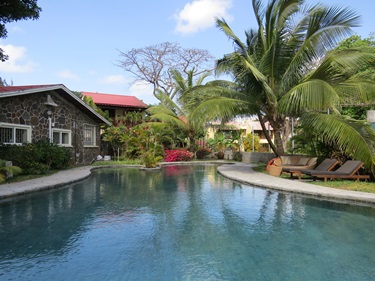
After lunch we drove down to the end of the beach near Trou d'Eau Douce and decided we'd had enough. We couldn't face returning via the chaotic traffic of the coastal road so we went inland ... but for such a small island, Mauritius has a bewildering profusion of roads - freeways (one only), main roads, secondary roads, gravel roads and (the ones we hated the most) unmarked roads. That meant several wrong turns, some garbled directions from locals and a few arguments before we found ourselves back at Pamplemousses again. From there it was straight shot on the freeway north to Grand Baie, followed by some serious relaxing at the pool with our books.
[Monday 21 September : Pereybere, Mauritius] We wanted to go on the submersible that leaves from Mont Choisy every hour and spends 45 minutes on the sea bed, 30 metres below the surface, but when we phoned to book they told us it was too windy - all trips had been cancelled for the day. Too windy? 30 metres underwater? That was odd, and a pity, because today was the only day we could do it. Instead we walked round the coast from our hotel to Grand Baie, alternately on beaches or over rocks, marvelling at the seared pink skin of the European tourists lying in the sun in front of their posh resort hotels.
Grand Baie is a bigger, louder and more crass version of Pereybere, with souvenir shops, touts hawking boat rides, taxi drivers haranguing you for business and even a "Spur" restaurant. We walked around, had lunch then caught one of the frequent local buses back to Pereybere - five minutes on the road compared to the two hours we took to walk round the coast.
[Tuesday 22 September : Port Louis, Mauritius] After six days of rest and relaxation at the Mauritian seaside it was time for some actual travelling. We checked out of our hotel in Pereybere, drove three kilometres to Grand Baie, returned the rental car we'd been using and humped our luggage to the bus stop 100 metres up the road. An express bus to Port Louis pulled up within minutes, we got on and just over half an hour later we were in Port Louis. Amazing; you have to keep adjusting your sense of scale on this island - everything is so close but you get deceived when you look at a map because we are used to distances being so much greater. Interestingly, there were a few other foreigners on the bus but without luggage; I guess they were staying at resorts on the north coast and decided to take the bus to Port Louis to break the monotony of being slow-roasted to a wrinkled and leathery death on the beach. The express bus is so fast they would easily be able to walk around Port Louis for a few hours, get the bus back again and be at their resorts in time to lay waste to the lunch buffet.
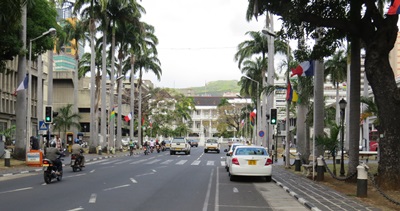
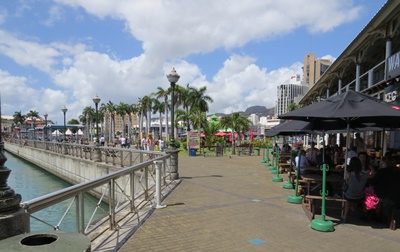
We needed our compass to negotiate the haphazard and hectic streets round the bus station, but by 10:30 AM we were at the hotel we'd booked into for the night. It was a bit of a dive and further from the city centre than we would have liked, but there are desperately few hotels in Port Louis and most of these are astoundingly expensive. Le Corail Hotel and Guest House certainly isn't going to win any Michelin awards, but the amazing thing was that the car park was full of very smart cars. Why were people with cars like that staying at such a dump? Not tourists, surely ... presumably they were businessmen, in the city on business and (just like us) not prepared to pay the exorbitant rates charged at the Sheraton and Radisson hotels. Port Louis is known for being a city of government departments and business but precious little else.
We dumped our gear in our room and strolled back to the city centre. The famed Port Louis market was, as all markets are, chaotic. We browsed around, bought one or two things (with the usual haggling) and enjoyed an excellent vanilla and coconut milkshake at a stall then moved on to the Caudan Waterfront. This is a new and very smart area next to the harbour that has been revamped in much the same way as the V&A Waterfront in Cape Town. There are restaurants at the water's edge, swanky clothing boutiques and even a Segafreda coffee shop ... which I can confirm from personal experience serves excellent espresso; in fact, it was the first REAL coffee I'd had in Mauritius (meaning it came from a proper espresso machine, not an automatic push-button device or a gravity-fed filter).
While we were in the city centre we visited the national museum, which catalogues in depressing detail how humans have been responsible for the destruction of much of the fauna and flora on Mauritius and Rodrigues. The dodo may be the international symbol of species extinction, but it is only one of many, many species endemic to Mauritius that have disappeared since the Dutch first settled on the island. Tortoises, birds, reptiles, fish and trees, the list goes on - all hunted, killed or cut down by greedy settlers. The dodo's demise was accelerated by the introduction of exotic animals like pigs and dogs that ate its eggs at a far faster rate than the unfortunate bird could lay them; having no natural enemies, the dodo was simply incapable of protecting itself. Efforts by the Mauritian government to protect and restore the environment are laudable but unfortunately too late for the many species that have gone forever.
[Wednesday 23 September : St Francois, Rodrigues] Our alarm clock buzzed at 4:45 AM, and at 5:30 AM we stumbled outside to find the taxi we'd ordered waiting for us. Even at that hour the streets of Port Louis were sprinkled with people as the taxi drove us to the bus station that serves the south of the island [Aside : Port Louis has two major bus stations, one for destinations in the north such as Grand Baie and one for the south (for example, Curepipe, Mahebourg and the airport). We arrived the previous day at the NORTH bus station but needed to depart from the SOUTH bus station].
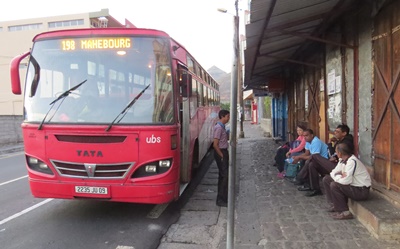
It was the start of a hard day of travelling to get from Port Louis to the island of Rodrigues, 563 kilometres east of Mauritius. The first leg of the trip was to get to the bus station in time for the earliest express bus to the airport (which was at 6:15 AM). We managed that easily enough, but despite my best efforts of the previous day to find out exactly when and where the airport buses departed from, we were still given the wrong information. At the south bus station we were told that buses for the airport left from a separate bus stop two blocks away ... which was very frustrating because we had taken a taxi just so that we wouldn't arrive hot and sweaty. So we walked round the corner and found the bus stop easily enough.
A chap sitting there confirmed that this was indeed where the airport buses departed from. "I'm also going to the airport" he said. "I'll tell you which bus to take." He told us that he lived in Goodlands in the north-east and took the bus every day to work in the airport - a commute of no less than three and half hours each way! He leaves home at 4 AM, takes the bus from Goodlands to Port Louis, walks from one bus station to the other then takes the bus to the airport, arriving there at 7:30 AM. In the evening he does the trip in reverse and gets home at 8 PM. And he does this five days a week, Monday to Friday ... incredible.
The bus to the airport was the second leg of the trip and the one that concerned me the most, because the scheduled arrival time at the airport was 7:26 AM and our flight to Rodrigues was at 8:50 AM. Sounds like more than enough time, but who knows how late these buses are? Turns out I needn't have worried at all, because the bus driver was a Michael Schumacher devotee and we went like the clappers. We also discovered that "express bus" in Mauritius does NOT mean "no stops" but rather "go like hell BETWEEN stops ... lots and lots of stops". So we hurtled southwards at high speed, overtaking any vehicle in our path and careering round traffic circles while two ashen-faced foreigners sat in the front, goggle-eyed with shock, white knuckles gripping their seats in desperation. And every few minutes the bus would screech to a halt at a stop in some random place to allow people to get on and off.
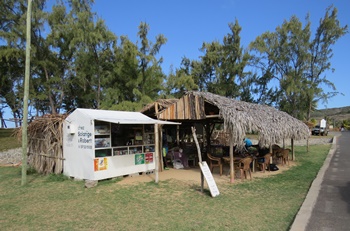
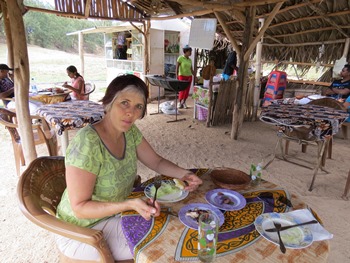
The result of this demonic ride through central Mauritius was that we arrived at the airport at 7:27 AM, a mere one minute late. It makes one wonder who thought up the bus schedule - if our driver from Hell just about managed to stick to the timetable, what chance does a mere mortal stand? There must be days when the bus is twenty minutes or more late. But we arrived at the airport in plenty of time for our flight so we were happy. The only slight complaint we had was that the conductor short-changed us by 25 Rupees, but considering that the journey across the entire breadth of the country cost only 34 Rupees each we decided to let it go [Aside : I gave the conductor 100 Rupees for two tickets that totalled 68 Rupees, and he gave me 7 Rupees in change rather than 32. I only realized the mistake afterwards when I looked at the tickets to see what the price was, and by that time he'd moved on to other passengers further back].
The flight across the Indian Ocean to the tiny island of Rodrigues was in a small turbo-prop aircraft and took an hour and a half (this was leg three of our trip and the easiest so far). We still had to go through passport control after we landed, which is odd because Rodrigues is part of the country of Mauritius - surely it's classified as a domestic flight?
The fourth and final instalment of this multi-leg trip was the minor mystery of how we were going to get from Rodrigues' airport to the guest house we'd booked into in the tiny village of St Francois, way over on the east side of the island. The island is only 18 kilometres wide, but it is very hilly and the roads wind like crazy, so the actual distance was probably about 35 kilometres. Our plan was to take the airport bus to Port Mathurin (the island's capital) then another bus to St Francois, a convoluted journey that would probably have taken two hours.
But as we were walking out of the terminal buildings we saw a guy holding a sign for Auberge St Francois. We stopped and spoke to him; he knew my name and said he was there to take us to the guest house. And that's where we made our big mistake, a mistake that we should never have made as seasoned travellers - we did not ask him the price of the trip but just assumed that it was a courtesy pick-up by the guest house. As we wound our way slowly eastwards I realized that the driver did not work for the guest house at all but was an independent operator, and I began to have a bad feeling about the trip. When we arrived he turned to us and said "That will be 900 Rupees". I looked at him in amazement. "900 Rupees? Are you crazy? That's far too much!". He tried to explain that petrol was expensive and he had to pay this fee and that charge, but I told him that we hadn't asked for the lift - he waited at the airport for us of his own accord.
Unfortunately he knew, and I knew, that we had accepted the ride which implied an implicit contract of payment so we had no choice - we HAD to pay. I managed to haggle him down to 800 Rupees, which was still an outrageous fee; if we had simply asked him at the airport BEFORE we got into his van we could either have negotiated him down to something like 500 Rupees, or if we were still not happy we could have gone on the public bus like we'd planned. But once we were in his van he had all the power. Idiots ... I bet he pulls that stunt on people arriving at the airport every day.
We checked in to the guest house then had some lunch at a tiny restaurant next to the beach made of palm fronds, wooden beams and a few oil drums. Our total lack of understanding of what the waitress was saying together with the fact that the menu was scribbled on a whiteboard (and half rubbed out) meant that what we thought we'd ordered was not what arrived. However, the food was good so no complaints ... For the rest of the afternoon we sat on the beach and read our books.
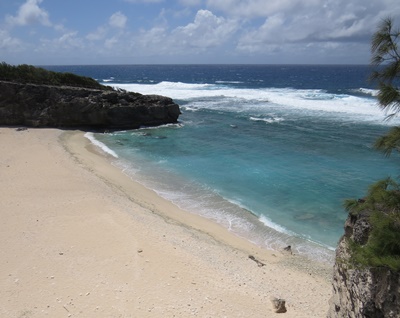
[Thursday 24 September : St Francois, Rodrigues] The terrace of the Auberge St Francois is a superb place to have breakfast - it is cool and shady and has a magnificent view out over the sea through the casuarina trees. Pity about the dreadful coffee, but I guess you can't have everything ...
After breakfast we walked southwards along the footpath that runs round almost the entire island. The path went through trees and on the clifftops, descending every so often to a secluded beach. The beaches on Rodrigues are wild, desolate and invariably deserted (unlike in Mauritius); we sat on Trou d'Argent beach for over two hours and did not see a soul the entire time. Unfortunately it was quite windy, so the beach experience wasn't quite as enjoyable as it could have been.
At midday we turned round and walked back again, having a late lunch on the way at a tiny cliff-top restaurant near St Francois. This restaurant, which also doubled as general store selling biscuits, cheese and other non-perishable food, was run by a strikingly beautiful young lady on her own; she was simultaneously the chef, waitress, manager, owner and manned the counter. She could not speak a word of English, did not have a menu and only served two dishes - chicken or octopus, both with rice and black beans. We each ordered chicken and went to sit outside, marvelling at the view from her makeshift terrace (corrugated iron sheeting covered with palm fronds, held up by a couple of poles hammered into the ground).
The food came and we tucked in with sighs of delight. We were in probably the most isolated restaurant on one of the most remote islands in the world, eating food prepared in nothing more than a shack, but everything was absolutely delicious. The chicken was so tender it fell off the bone, and the bones themselves told the tale of how free range the chicken had been before it met its untimely demise - they were long and ruler-straight, with none of the bending that you find in "battery" chickens. The meal was simple but undoubtedly one of the very best I've ever eaten.
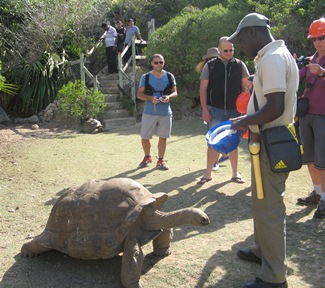
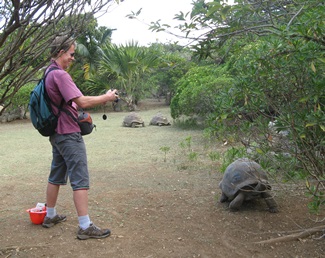
For some reason all of these road-side restaurants on Rodrigues seem to be called "Chez" something, and this one was no exception - it was named "Chez Dana". But in Port Mathurin the convention was to call your restaurant "Joe's Snack" (if "Joe" was the restaurant owner's name).
After lunch we walked up the coast the other way, north towards Pointe de Coton, location of the most exclusive hotel on Rodrigues - the Coton Bay Hotel. The wind was much worse than it had been in the morning and for the first time since arriving in Mauritius we were actually cold. But when we got to Coton Bay we discovered why this particular spot was chosen for an expensive resort - the bay is almost completely protected from the easterly wind, and the perfect beach in front of the hotel was calm and windless. Yet a hundred metres away over the rocks it was a howling gale.
[Friday 25 September : Port Mathurin, Rodrigues] Today was a day of riding buses, island-style. First it was a trip of about 45 minutes from St Francois north-west over the mountain in the middle of the island and down the other side to Port Mathurin, capital of Rodrigues. Rodrigues is a volcanic island and thus very mountainous; every road from the coast goes steeply up (usually via Mont Lubin, the geographic centre and also near the island's highest point) and then twists down again the other side. The roads are narrow and hairpin bends are common, many of them so sharp that any sizeable vehicle (like a bus) cannot negotiate the corner without taking up both lanes. Oncoming traffic has to look ahead and stop if they see a bus or truck trying to get around one of these bends, but drivers here are accustomed to this and are very cautious.
We arrived at Port Mathurin bus station after a tortuous descent and much screeching of brakes. Accommodation options are very limited in Port Mathurin, but after walking around for a while we secured a very nice room at Le Flamboyant Hotel; we even managed to negotiate a discount because we were staying two nights. Then it was straight back to the bus station for another ride of about an hour to the south-west corner of the island - which again meant a slow crawl up to Mont Lubin and a twisty descent down from there. We wanted to visit the Francois Leguat Giant Tortoise and Cave Reserve, but had established that no bus went down the minor side road leading to the reserve; the only way to get there was to take a bus to Pleine Corail and get off at the turn-off. "Don't worry, it's only a fifteen minute walk" the girl at our hotel's reception told us. I've heard directions like that before so I was somewhat sceptical, but what could we do?
The bus driver duly stopped at an intersection and pointed down a side road. "That way" he said. So we started walking ... and kept walking ... and walking. Just short of half an hour later we came to a sign pointing down a gravel track. "Francois Leguat Reserve, 750 metres" it said. Holy mackerel, another 750 metres! When we eventually arrived at the reserve's reception area I checked my watch and saw that it had taken us 34 minutes from the bus stop; so much for the predicted time of fifteen minutes. Inside we found that you could only get into the reserve with a guided tour by a ranger, but at least in that respect our luck was in - the next tour was leaving in five minutes. We were given red hard hats and followed the ranger into a canyon with a flat, grassy floor and steep cliffs on both sides.
The tortoises in this reserve are not endemic to Rodrigues - both types of Rodriguan tortoise became extinct in the early 1700's. The tortoises here are the "Aldabra giant tortoise" species from the Seychelles, the closest living relative to those originally found on the island.
Almost immediately we came across a group of truly enormous tortoises, bigger than any I've ever seen before. The largest, and oldest, was 105 years old. "And he will get a lot bigger" said the ranger. "He could live as long as 200 years and will never stop growing". The feet of the biggest tortoises were way bigger than mine! They were also very tame, and would come up to you, stretch out their necks and expect to be scratched. After interacting with the tortoises for a while we climbed up onto the plateau and entered quite an extensive cave system, the reason why we were given hard hats - some of the passages were narrow and low. Like all caves it was dark, gloomy and dank, but the stalactite and stalagmite formations were well lit so it was quite interesting.
The tour of the reserve finished at about 4:30 PM, and we were about to go into the restaurant to get a bite to eat when we thought it might be a good idea to ask about the time of the last bus back to Port Mathurin. The girl at reception looked at us in horror. "The last bus goes past at 5 PM" she said. "You'll have to run!" She was right - it had taken us over half an hour to walk to the reserve from the main road, and now we had to make it back in less time. We dropped any thought of eating and started jogging. I wasn't too worried; we'd walked quite slowly on the way in and had stopped a few times to take photographs, so with a little bit of effort we should easily be able to cover the same distance back again in about twenty minutes.
Just as we reached the end of the 750 metre section of gravel track leading into the reserve, a motorcycle pulled up next to us. It was Jacques-Maurice and Ariel, a young couple we'd met in the reserve and to whom we'd called hasty goodbyes as we ran out of the reserve reception area. Ariel climbed off the back of the motorcycle. "We thought about it" she said. "Jacques can give Karen a lift to the bus stop, then come back for Paul, then come back for me. That way you'll definitely make it." They'd overheard the conversation about the last bus and had wished us good luck as we ran past them.
So Karen donned Ariel's helmet, climbed on the back of the bike and Jacques-Maurice motored off while Ariel and I continued at a fast walk. A few minutes later Jacques-Maurice was back, I climbed on and the process was repeated. I got off at the intersection with the main road well before 5 PM. "Thanks very much" I said. "You saved us a lot of sweat and effort."
"No worries" replied Jacques-Maurice with an amiable grin. "Enjoy your stay on Rodrigues. Au revoir!" He roared back down the road to pick up Ariel while I strolled to the bus stop about fifty metres away. Karen was there, along with several other people including the ranger who had conducted our tour of the tortoise reserve. "How did you get here so quickly?" I asked him in amazement. He had been at the reserve when we'd started running back, and no cars or people had passed us heading in the same direction.
He smiled. "There's a short cut over the hill - very quick if you know the way". The penny dropped - maybe that's what the girl at our hotel's reception had meant when she said it was only a fifteen minute walk. We had intended to ask the ranger if there was another way back, because the road we'd walked in on was anything but direct, looping and twisting back on itself several times, but we'd left in too much of a hurry. However, thanks to Jacques-Maurice and his motorcyle we were well in time for the bus; without him we might have been in trouble because the bus arrived at 4:55 PM, five minutes earlier than we'd been told.
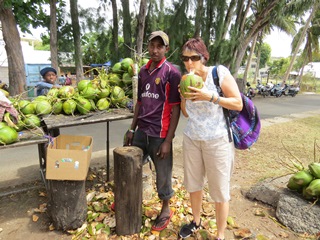
That evening we walked the darkened streets of Port Mathurin looking for somewhere to have supper. Every shop was closed and there are very few street lights, but every now and then we'd come across an oasis of light; these were usually small restaurants, often nothing more than a shack with a hole in the wall, but we saw locals coming and going from them. "Local" restaurants are few and far between in Mauritius and Rodrigues for the simple reason that, from what we could see, locals seldom eat out - they either cook and eat at home or get take-away food from these hole-in-the-wall places. So almost all the restaurants we'd eaten in thus far had been aimed at tourists.
But in Port Mathurin we came across "Nila's Snack" and went inside. It was a hive of activity with people coming in and out, greeting each other, ordering food or just standing around talking. Nila himself served us - chicken with fried rice for me and octopus with rice for Karen. The food was dirt cheap (compared to the tourist places we'd been to) and delicious. The only disappointment was that the menu advertised Nespresso (a rare commodity on these islands) but when I tried to order a cup Nila said that his machine was broken. Apart from that it was an excellent meal, once again proving that the best food is usually to be had in small back street restaurants serving locals rather than the swanky main street places.
[Saturday 26 September : Port Mathurin, Rodrigues] Saturday is market day in Port Mathurin, so people from all over the island converge on the capital to buy, sell and socialize. There were people streaming into town from the bus station and every street corner had a traffic cop on duty to direct cars. The market isn't that big, but it is clearly the main event of the week on Rodrigues. We didn't do much shopping but did buy a fresh coconut from a vendor and drank the juice after he'd expertly slashed it open with a few strokes of a seriously wicked-looking machete. Unfortunately the actual flesh wasn't very nice - it was soft and pulpy, like a very soft-boiled egg, not at all like the few bits of raw coconut I've eaten in the past.
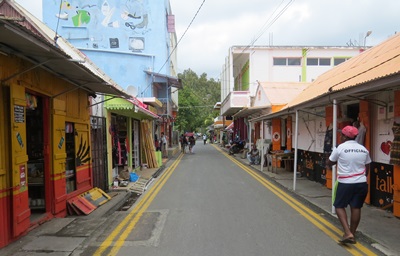
In the afternoon we strolled eastwards on the coastal road until we came to Anse aux Anglais (English Bay), a delightful little village about two kilometres from Port Mathurin. It is so named because this is the spot where English troops landed in 1809 in preparation for their assault on Mauritius, then in the hands of the French. There isn't much of a beach and we certainly didn't spot any stray English soldiers from the 19'th century, but the village itself is very attractive; the fact that it contains three luxury hotels is testament to its popularity.
Supper that night was at another local restaurant in Port Mathurin, a place that appeared to be a cut above Nila's Snack of the night before. This time there was real coffee (albeit from a Nespresso machine) and the food was again excellent.
[Sunday 27 September : Blue Bay, Mauritius] Our flight back to Mauritius from Rodrigues was at 10:55 AM, so the 8:45 AM bus to the airport seemed perfect - the trip takes just over an hour. We had no worries about timing, because we'd seen first-hand how efficient is the bus system on these islands. We boarded the bus at the Port Mathurin bus station at 8:40 and waited ... and waited ... and waited. Nothing happened. No driver or conductor arrived. At 9 AM we were getting worried, so Karen went to the dispatcher's hut and asked what was going on. The guy there, who I had spoken to the day before, jumped off his chair in alarm, swearing in French. Shouting and gesticulating followed, and within two minutes a driver and conductor materialised and our bus roared into life. We left at 9:05 AM, twenty minutes late, which meant we were now cutting it fine for our flight. But if Karen had not spoken to the dispatcher, who knows how long we would have sat there? The other passengers didn't appear worried; it was a Sunday morning after all, so I guess we were on island time ...
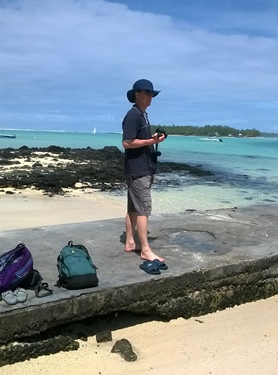
The bus inched up the steep hill out of Port Mathurin with us checking our watches anxiously. And, of course, we stopped at every bus stop on the way to allow people to get on and off in their slow, languid, island-style way. Even after we'd crested the hill at Mont Lubin and started descending the driver insisted in crawling sedately along and I had to force myself not to grind my teeth in frustration. If we missed the flight back to Mauritius it would mean that we would also miss our flight to South Africa the next day, so this late and painfully slow bus ride was becoming a serious concern. But suddenly, and for no apparent reason, the driver sped up dramatically. The engine roared and we began hurtling round tight corners, the rear of the bus (where we were sitting) swaying wildly from side to side. Bus stops were treated like a Formula 1 pit stop for a quick tyre change - we flew up to each stop without any noticeable sign of slowing down, then had to hang on desperately as the driver stood on the brakes at the last minute. The other passengers hardly stirred from their Sunday morning torpor; nerves of steel or resigned acceptance? Perhaps a bit of both.
But we were grateful that, at last, there was some urgency. Luckily the bus stop at Pleine Corail is only about 150 metres from the terminal building of the airport (and downhill), so when we drew to a halt at 10:20 AM we were out and running. We checked in for the flight to Mauritius with minutes to spare; the lady at the counter told us that we were the last passengers to arrive (reminiscent of our close call in China a few years ago when we nearly missed the Lanzhou-Xi'an overnight train). Holy mackerel, we've got to stop doing this to ourselves - my nerves can't take it any more.
After all that our flight was delayed because a seriously ill person had to be taken on board via an ambulance. He was strapped into a stretcher and laid across three rows of seats at the back. And when we landed in Mauritius one of the other passengers had to be taken off by ambulance; we'd seen her looking very sick and being given oxygen during the flight. Then when we tried to retrieve our luggage my bag did not appear - we were the last people still waiting and the carousel was completely empty. What now? How can luggage disappear between Rodrigues and Mauritius? For heaven's sake, there are only two flights a day from the tiny airport on Rodrigues! I walked over to an Air Mauritius lady nearby and was about to query things when I saw out of the corner of my eye a familiar backpack shoot up out of the carousel hatch. I quickly told the lady not to worry and grabbed my bag. I wonder what happened? How can ONE bag appear ten minutes after all the rest? Did it fall off the trailer between the aircraft and the terminal buildings? Very weird.
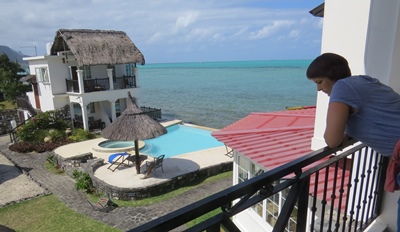
By now we were familiar with the bus system so getting into Mahebourg from the airport was a snap. On our last night in Mauritius we weren't staying in Mahebourg itself but in a place on the road south to Blue Bay, right next to the sea - we'd checked it out when we were in Mahebourg previously.
[Monday 28 September 2015 : Cape Town, South Africa] Another early morning saw us on a 6 AM bus to the airport; for once we were there in plenty of time for our flight back to South Africa and even managed to have a leisurely breakfast after checking in. We converted all our remaining Mauritian Rupees to US Dollars and five hours later we were in Johannesburg. Our third flight in two days was the Johannesburg-Cape Town leg, and by the time we landed we were thoroughly sick of airports and flying. How do people cope with business commutes twice a week (or even more often)? It would drive me insane.
Where to next? Nepal in 2016 is the plan; Karen and I have been wanting to walk the Annnapurna Circuit in the Himalayas for years. Our reasoning is that we aren't getting any younger, so the sooner we cross that off our bucket lists the better ...